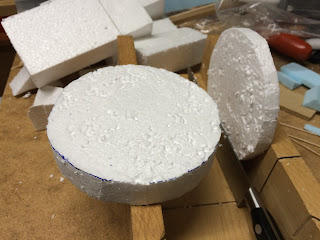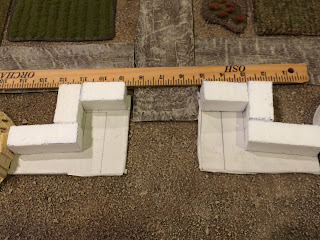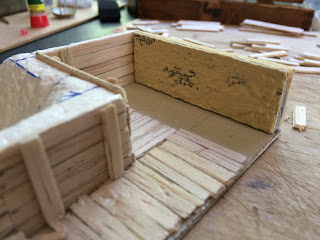A while back when I set up the terrain for my "Bala Hissar or Bust!" scenario, I wasn't paying much attention to the British Cantonment located outside the walls of Kabul. I looked for some 18th Century earthworks I added to my collection years ago, to use for the walls. I didn't know if I had enough to cover the entire perimeter, but I wasn't able to find them anyway (I think they are with some hobby stuff in storage), so I looked for some walls, which I had a large collection of. They wouldn't have been perfect but would have worked for the game... except I couldn't find them either. ARGHHH!!! So I ended up using a set of Rorke's Drift style mealie bags -- which I had just enough of, thank goodness -- to lay out the perimeter of the Cantonments. It worked for the game but obviously was not even close to an accurate representation of the earthwork walls with round bastions at the corners of the real British Cantonments erected in 1840 and abandoned by the ill-fated British and Indian army and its many civilian camp-followers in January 1842.
Needless to say, when that first play-test game -- which was a lot of fun and which I hope to refight multiple times -- ended, it didn't take long for me to start obsessing over how best to provide a more historically accurate version of the British "start-point" for the game.
I poured over the various First Afghan War history books in my collection, and the First Afghan War chapters in other books, employed my Google-Fu, and even posted a question to the Victorian Wars Forum -- which happily garnered several responses, including one by noted author Colonel Mike Snook.
I got some new info on the environs of Kabul, but sadly no new info regarding the Cantonments themselves. Still, I already had enough to start trying to source an appropriate commercially made model...
I found one strong contender on eBay -- a series of very nice looking generic earthwork entrenchments made by Red Dragon Gaming in the UK (visit their well-designed and easy to navigate website by clicking HERE), usable for games from Medieval to Modern times...
But unfortunately the details on some of the individual component pieces and how they fit together didn't work that well for my purposes, and though fairly priced they were not inexpensive... it seemed a bit silly to spend so much on something that in the end would not be quite right. I found some other commercial terrain choices also, but none were really as good as that first choice from Red Dragon, so... I decided to build it myself.
I hadn't planned on and really did not particularly want to build it for myself, but for whatever reason, that's what I decided to do.
It's been about 3 weeks since I started the building process, and I'm about halfway done, having completed 3 out of 6 earthwork entrenchment sections needed. When that's all done I'll build a section for the wooden entryway, which I managed to find a real world prototype for during my online search, which I think may turn out pretty well.
Here's the camp entranceway reference photo I found:
It shows a reconstructed gate of FORT WARD, built by the Union Army in Alexandria, Virginia, early in the American Civil War. The gates will be higher to allow for entry and exit by camel and elephant, as well as lower-to-the-ground men and horses.
When I'm done with the 28mm scale version of that gate, I may push on and build another 2 round corner bastions and another pair of entrenchments for the Cantonment's Western wall, which is left off the table in the current layout, for use in future games. Having at that point finished the other two-thirds or so of the entire fortification, it would be nice to finish the rest, as I think it could be useful for some other early to mid-19th Century conflicts, including battles such as Puebla from the French Intervention in Mexico.
The last big question will be how to paint and finish these pieces, as I'm building them for a game set in the depth of a harsh Afghan Winter. A big part of me will want to add snow to the whole deal... but a more farsighted part will want to keep it consistent with the rest of my Afghan/Arid terrain, and just dust it with some temporary model snow like the rest of the table probably will be. But I'll cross that bridge over the snow -- or no snow -- when I come to it, which won't be for at least a little while yet.
I took a couple of wrong turns in the road during the course of this build, from which I had to double back. At least one is explicitly on view below, where I created what I came to see as TOO WIDE an entryway to the corner bastion. Luckily for me the materials in use -- styrofoam and balsa wood -- allow for some recalibration!
NOTE: the bases for the terrain pieces below are all cut with scissors from inexpensive self-adhesive vinyl floor tile.
Like MacArthur, I shall return -- not to the Phillipine Islands, but with a follow-up post when I'm done with the second half of the Kabul Cantonment, hopefully in the near future!
FAIR WARNING: there are A LOT OF PICS below...














































































































































































































Lovely build and as you have indicated usable from Vauban era to ww1
ReplyDeleteBest Iain
Great work. I look forward to see the finished work!
ReplyDeleteYour patience in documenting your work in progress is inspiring.
ReplyDeleteIt's curious how every western army that goes to Afghanistan, up to the present day, invests so much effort in fortifying its camps, forts, FOBs, etc. All that's missing is the HESCO barriers. Colonial warfare is colonial warfare, I guess.
Shaping up nicely! It certainly has versatility.
ReplyDeleteMy long belated thanks for your kind comments, gentlemen! I've been having difficulty posting comments here on my own blog, which as I'm sure you can imagine is a bit frustrating! At the same time, I've continued working to complete the Cantonment, which I'm just about done building, though I have yet to paint any of it. Hopefully I'll get a new post up soon, which will mostly focus on the working double-doors of the gateway. @Michael Peterson: very happy to hear I was able to provide a bit of inspiration, it really is the best possible outcome from this blog of mine. Re: the missing HESCO barriers and the somewhat unchanging nature of colonial warfare... with regard to the British Kabul Cantonments of 1840-42, truth is they were in no way satisfactory from a militarily defensible point-of-view, and many were the officers who said so at the time they were first built. It's unlikely though not impossible the Afghans would have been able to overcome a stronger defensive encampment which properly included ammunition, pay, and foodstuffs within its own walls to supply the garrison stationed there. Then again, I suppose it could be said the French did much the same at Dien Bien Phu, with unfortunately similar results.
ReplyDeleteIt looks amazing!!!!! Built with the skill and precision of one of her majesty's Royal Engineers and the deft of hand and experienced eye of an artist.
ReplyDeleteLooking forward to the completed model.
Cheers,
JB